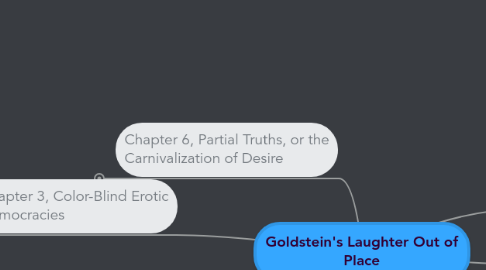
1. Chapter 2, The Aesthetics of Domination
1.1. Domestic Work
1.2. Workers wages are not enough to live on
1.2.1. Employing a domestic worker is a class marker
1.3. Middle class is defined by the ability to pay someone else to do their manual labor
1.3.1. Dramatic change in the increasing feminization of its workforce and the participation of children
1.3.2. A major indicator of change in the division of classes was the fact that Gloria was able to eat the same food that she prepared, which was not always the case
1.3.2.1. Labor practices mirror savery
1.3.2.1.1. Affectionate relationships do develop between the employed and employers
1.4. Public schools are mediocre, so good schooling is not available to the poor. limiting their opportunities
1.5. Laughter Out of Place
2. Chapter 3, Color-Blind Erotic Democracies
2.1. When Eliana is seen with her light-skinned grandson, it is assumed that she is the lower-class nanny and he is the upper-class whit child
2.1.1. Race vs. Class
2.1.1.1. Traits that are considered "African" are shunned, as they are taken to represent clavery
2.1.1.1.1. Ana Flavia Pecanha Azeredo
2.2. Living in a favela is an automatic class marker in Brazil
2.2.1. coroas
2.2.1.1. Representations of black bodies
2.3. European men and "Indian" women began mixing races (1800's, Freyre)
2.3.1. Low in come, mixed race and black women are at the bottom of several class hierarchies
2.3.1.1. Anthropologists have found race and sexuality difficult to address, and may be surrounded with silence and jokes or humor
2.3.1.1.1. low-income women would consider using their sexuality to receive help from the coroa
3. Chapter 6, Partial Truths, or the Carnivalization of Desire
3.1. Sexuality and Poverty
3.1.1. masculinist version of desire and transgression
3.1.2. sexuality is key metaphor to Cariocas; sexual joking and teasing is a verbal confirmation of the centrality of sexuality to social life
3.1.2.1. ageless interest in sex talk
3.1.3. New node
3.2. The Carnivalization of Desire
3.2.1. self-promoted image of an eroticized "tropical paradise"
3.2.1.1. body liberation/revealing clothing style
3.2.2. public flirtation
3.2.2.1. pleasurable and complimentary of women's bodies
3.2.3. male homosexuality
3.2.3.1. upper and lower class models
3.2.3.1.1. active and passive
3.2.4. Brazilian feminists
3.2.4.1. avoidance of body issues and sexuality
3.2.4.1.1. leaves poorer, darker skinned Afro-Brazilians in position of second-class citizens
3.2.4.2. discourse finds voice through humor
3.3. Sexual Culture in Felicidade Eterna
3.3.1. Sexual/Eating metaphors
3.3.1.1. comer- to eat/to consume sexually
3.3.1.2. women generally seen as passive; the "dar" or give
3.3.1.3. you are defined by whether you are a person who eats, or one who is eaten
3.3.1.4. women break off relationships with men who literally eat (consume) too much and produce too little
3.4. From Boys to Men: Normative Masculinization and Heterosexuality
3.4.1. class-specific regimes of sexulaity
3.4.1.1. if not blessed with money, at least blessed with good sex
3.4.2. believed that it is unhealthy for men to go too long without sex
3.4.3. Gloria desired to plan Luca's first sexual experience
3.4.3.1. double standard for male and female children
3.5. Sacanagem
3.5.1. linking "notions of aggression and hostility, play and amusement, sexual excitement, and erotic practice in a single symbolic complex"
3.5.1.1. can be good or bad
3.5.2. padastros- dangerous men, or stepfathers
3.5.2.1. the one who raises you does not "eat" you
3.5.3. sexual abuse
3.6. Partial Truths
3.6.1. poor women are left as the guardians against a socially constructed transgressive male sexulaity
3.6.1.1. epidemic of child sexual abuse
3.6.1.1.1. training of young boys for manhood
3.6.2. women constrained by the sex-positive language and attitudes that make it hard for women to protest male infidelity or govern male transgressive sexuality
4. Chapter 7, What's So Funny About Rape
4.1. Marila's failed attempt to murder her husband
4.1.1. Celso neglected his young family
4.1.2. abusive, unfaithful
4.2. Evening of Terror
4.2.1. laughter and rape
4.2.2. Gloria's family assaulted
4.2.3. rape of a child is cause for murder in shantytowns
4.2.4. downplay trauma with humor
4.3. Battling Mothers and Daughters
4.3.1. Anita pregnant after rape
4.3.2. actually from her boyfriend Gabriel
4.3.2.1. Gloria insisted she abort
4.3.3. when daughters lose virginity, they must move from the house
4.3.4. Gloria's storytelling of the rape allowed her to criticize teenage pregnancy
4.3.4.1. daughters should demand economic support from their men
4.3.5. highlight suffering through narrations
4.4. Legal Universe and Rape
4.4.1. distrust and fear of the police
4.4.1.1. rapes aren't reported
4.4.2. anachronistic legal codes regarding class, race, gender, and sexulaity
4.4.3. differences between upper and lower classes in court
4.4.3.1. adjudication difficult
4.5. Black Humor as the Only Response
4.5.1. humor understood in its place
4.5.2. dominated class have few options but absurd laughter
4.6. Conclusions
4.6.1. understanding humor can provide a unique window into how impoverished working women in the shantytowns of Rio understand and experience their lives
4.6.2. deepening layers of context to stories
4.6.3. women are not always passive to the discourses of domination that constrict their lives
4.6.4. How to integrate democratic law into the "brown zones?"
4.6.4.1. gang retaliation still permeates
4.6.5. progress is slow
5. Introduction, "Hard Laughter"
5.1. Humor as a theme
5.2. Residents of the "shantytowns" feel separate from outside forces
5.3. Laughter was everywhere
5.3.1. Finding the meaning in the humor is a means of discovering a culture
6. Chapter 1, Laughter "Out of Place"
6.1. First Arrival
6.2. Scholar In Training
6.3. Carnival
6.3.1. Habits of Class and Domination
6.4. Aim was not only to explain why something was funny, but to capture the ethnographic context
6.4.1. Class relations of women living in shantytowns during the late 20th century
7. Chapter 4, No Time for Childhood
7.1. Pedro Paulo
7.1.1. Children
7.1.1.1. City Walls
7.1.1.1.1. Street Children
8. Chapter 5, State Terror, Gangs, and Everyday Violence in Rio de Janeiro
8.1. Violent Crime
8.1.1. Local Gangs led by "reasonable" persons
8.1.1.1. Seduction
8.1.1.1.1. For middle and upper classes, some sembalence of law exists
8.1.2. Drug-Trafficking
8.1.2.1. Dlmer
8.1.2.1.1. Ivo
8.1.2.2. "Police-Bandits"
8.1.2.2.1. Revenge
